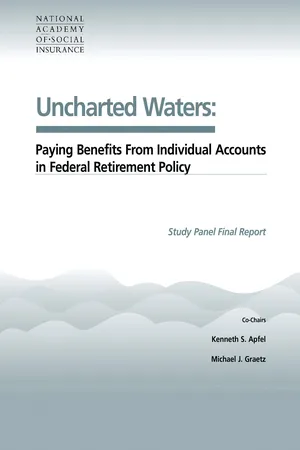Business
Annuities
Annuities are financial products that provide a series of payments over a specified period. They are commonly used for retirement planning, offering a steady income stream. Annuities can be structured in various ways, such as fixed, variable, or indexed, and can be purchased through insurance companies or financial institutions.
Written by Perlego with AI-assistance
Related key terms
1 of 5
12 Key excerpts on "Annuities"
- eBook - ePub
Wall Street Potholes
Insights from Top Money Managers on Avoiding Dangerous Products
- Simon A. Lack(Author)
- 2015(Publication Date)
- Wiley(Publisher)
Fast-forward 27 years, and the insurance industry has not changed much, but as most of the current and soon-to-be retirees know, interest rates certainly have dropped and the US equity markets are trading near their all-time highs. The insurance companies still market annuity products using shiny brochures and complicated documentation and claim to provide excessive above market guaranteed returns.What Is an Annuity?
Annuities were originally developed in Roman times; A.D. 225—A Roman judge produced the first known mortality table for “annua,” which were lifetime stipends made once per year in exchange for a lump-sum payment (Marvin Feldman 2012).An annuity is a contract between you and an insurance company that is designed to meet retirement and other long-range goals, under which you make a lump-sum payment or series of payments to an insurance company. In return, the insurer agrees to make periodic payments to you beginning immediately or at some future date (SEC.GOV n.d.).Annuities typically offer tax-deferred growth of earnings and may include a death benefit that will pay your beneficiary a specified minimum amount, such as your total purchase payments. While tax is deferred on earnings growth, when withdrawals are taken from the annuity, gains are taxed at ordinary income rates and not capital gains rates. If you withdraw your money early from an annuity, you may pay substantial surrender charges to the insurance company, as well as tax penalties.Here's how an annuity works: You make an investment in the annuity (give the insurance company an upfront lump sum), and it then makes payments to you on a future date or series of dates. The income you receive from an annuity can be paid out monthly, quarterly, annually, or even in a lump-sum payment. The sizes of your payments are determined by a variety of factors, including the length of your payment period. You can opt to receive payments for the rest of your life, or for a set number of years.Annuities aren't one-size-fits-all panacea investments, and they are not too good to be true, even though too many are sold that way. Sometimes they work well when placed properly in a diversified portfolio, and fully understood for the contractual realities of the policy. So let's take a closer look at the different types and the reasons you might want to stay away from the annuity sellers. - eBook - PDF
- (Author)
- 2015(Publication Date)
- Wiley(Publisher)
The annuity contract is often used as a tax‐deferred retirement sav- ings strategy once other qualified options have been exhausted. Annuities provide investment structures that may be viable alternatives to portfolio strategies outside of an annuity contract. These alternatives may come with various company‐backed guarantees of value or investment performance in addition to potential death benefits coupled with probate avoidance, which could be appealing to certain consumers. With that said, the method and calculation of growth in the contract and the taxation of distributions from the contract have unique complexities with which the financial planner must be familiar. Annuities are financial instruments primarily used for retirement plan- ning that combine elements of insurance and investments into one contract. In its simplest sense, the annuity contract is the opposite of a life insurance contract; whereas a life insurance contract protects against the possibility of untimely death, the annuity is designed to protect the client from living too long (i.e., outliving one’s financial resources). The insurance component utilizes mortality data to guarantee a lifelong income stream to individuals, couples, or a group of individuals. It is the insurance component that makes Annuities a unique financial instrument for retirement planning, as planners can establish a base of income for the client. They also provide the client with a tax‐deferred method of accumulating additional funds when quali- fied plan contributions have been fully funded. Annuities are categorized in several different ways based on the frequency of contributions, the date distributions begin, and the investment options chosen. Due to the com- plexity, wide availability, and potential controversy of Annuities, financial Distribution Options 215 planners must be intimately knowledgeable about the various forms of an- nuity contracts. - eBook - ePub
- OECD(Author)
- 2016(Publication Date)
- OECD(Publisher)
Finally, annuity products may be purchased at an individual retail level or for a group of individuals. Individual Annuities are more commonly purchased by individuals within personal defined contribution pension schemes, for example, or other voluntary personal pension arrangements. Group Annuities, on the other hand, are more commonly arranged by employers for a group of their employees.Beyond the basic structures outlined above, annuity products can offer various guarantees for the individual annuitants. These guarantees can insure the individual against several risks, namely longevity, death, investment and/or the loss of purchasing power.The insurance against longevity risk is the risk most commonly associated with annuity products, as annuity products which provide payments for the lifetime of the individual insure against the longevity risk of outliving their assets in retirement.Annuity products may also offer a guaranteed payment to the surviving beneficiaries of an annuitant in the case of death. This can take the form of a lump-sum payout contingent on the death of the annuitant, the provision for a lifetime payment to the surviving spouse, or the provision of a guaranteed period during which payments continue for the specified number of years regardless of the survival of the annuitant.Investment guarantees are also common guarantees provided by annuity products, either implicitly through the guarantee of a specified level of income or explicitly through a guaranteed minimum return on the assets underlying the annuity product. These types of guarantees provide insurance against the investment risk of a decrease in asset value which could significantly reduce the level of assets available for financing retirement.Annuities can also provide protection against the loss of purchasing power from inflation by indexing the guaranteed payments to the inflation rate, guaranteeing a level of income in real terms rather than nominal terms.In addition to guarantees, annuity products can also offer varying levels of flexibility to the consumer, providing options with respect to the access to underlying assets and the timing and/or level of payments. For the traditional annuity product, the consumer completely relinquishes the premium assets to the annuity provider, and has no ability to get out of the contract or change the terms on which the income will be received. Variations on this traditional product, however, can offer additional flexibilities to the consumer such as control over investment decisions, the ability to withdraw from or surrender the product, or the ability to vary the level or timing of income received during the pay-out phase. - eBook - PDF
- S. Bobby Rauf(Author)
- 2021(Publication Date)
- River Publishers(Publisher)
When an annuity represents a set of equal, annual, payments made by an investor, in an effort to accumulate a certain future value or sum, it can be referred to as, simply, annual payments . 1 2 Finance and Accounting for Energy Engineers There are many different types of annuity products available in fnancial markets. Life insurance annuity, deferred annuity, immediate annuity and annuity with period certain are a few examples of annuity products. Annual Payments: When an annuity is associated with a set of equal, annual, payments made by an investor, in an effort to accumulate a certain future value or sum, it is referred to as annual payments. Equal, periodic payments made to retire debt are also referred to as annual payments . See the defnition for sinking funds for additional details on this topic. Balloon Payment: A balloon payment is a large fnal payment necessary to retire a debt issue or a loan. Example: Consider a private utility frm that borrows $5 million from a commercial bank to fund a base load fuel cell electric power generating plant. The utility company’s debt note or contract calls for an annual payment plan of $500,000 per year for four years. At the end of the 4-year period, the utility company promises to remit a lump sum of $4.5 million to the bank, as remaining balance of principal and interest. The $4.5 million in this case would be referred to as a balloon payment. The total interest paid in this case would be $1.5 million. Bonds : A bond is a note or a fnancial instrument issued by a state, city, local government or the federal government to raise capital for their day-to-day activities or for specifc projects. Such projects, typically, pertain to the devel-opment of local, state or federal infrastructure such as roads, utility systems, bridges, hospitals and higher education institutions. A bond can also be considered as a type of loan taken out by compa-nies. - eBook - PDF
Private Money Management
Switching from Mutual Funds to Private Money Managers
- Julie Stone, Larry Chambers(Authors)
- 2001(Publication Date)
- CRC Press(Publisher)
148 22 22 What Are Annuities? nnuities are a popular retirement savings vehicle. But investors should consider their options and costs carefully before purchasing one. You won’t get into too much trouble as long as you think of yourself as a sheep drinking from the wolves’ stream. Just read the fine print. Overview In general, there are two types of Annuities, fixed and variable. A fixed annuity provides a specific income for life. With a variable annuity, payouts are dependent on investment return, which is not guaranteed. Variable annu-ities offer the choice of several investment divisions such as stocks, bonds, and money market funds, which can cause the rate of return to fluctuate with market conditions. In both fixed and variable Annuities, you do not have to pay income tax on the accumulated earnings until payouts start. But you should keep in mind that withdrawals are taxable and, if you are under age 59 1 / 2 , may be subject to a ten percent tax penalty. Fixed Annuities The word “fixed’ is used to describe the type of annuity referred to by the interest rate paid by the issuing insurance company. The fixed annuity offers security in that the rate of return is certain. Typically, with a fixed annuity the insurance company declares a current interest rate and sets the interest rate. It promises to pay at a lower rate than the rate it expects to earn on its A What Are Annuities? 149 investment. The difference in rates is sometimes referred to as the “spread.” It allows the insurance company to recover its administration cost and profit. The fixed aspect of the annuity also offers security in that the annuity holder does not take responsibility for making decisions about how the money should be invested. Also, the amount of the benefit that will be paid out of the annuity when the contract is annuitized is also fixed. The settlement options that the annuitant would receive from the insurance company would be the same each year during the annuitization phase. - eBook - PDF
Actuarial Models
The Mathematics of Insurance, Second Edition
- Vladimir I. Rotar(Author)
- 2014(Publication Date)
- Chapman and Hall/CRC(Publisher)
Chapter 9 Annuity Models 1,2,3 An annuity is a series of payments made at certain intervals (as months or years) during some period which is, as a rule, random. Typical examples are pensions which are life Annuities paid while the retired person lives, or an alimony which is paid until one of spouses dies. As a good (and often convenient) approximation, actuaries use also models where annu-ity payments are carried out in a continuous-time fashion. Regular payment of premiums by an insured, say, in the case of life insurance, is also an annuity. In this case, the annuitant —that is, the party receiving the annuity—is the insur-ance company, while the single payment of benefits constitutes the losses of the company. Accumulated values, though they are strongly connected with Annuities, will be consid-ered in Section 10 .1.3 after we consider the notion of a net premium rate. Below, we systematically explore two models: continuous-time and those where pay-ments are provided at the beginning of certain periods, that is, in a discrete way. 1 TWO APPROACHES TO THE EVALUATION OF Annuities 1.1 Continuous Annuities For certainty, we adopt a year as a time unit. Consider an annuity that is payable continuously at a rate c t depending, in general, on time. More precisely, we assume that the payment during an infinitesimally small interval [ t , t + dt ] is equal to c t dt . One may compare it with a water flow pouring into a basin with an instant speed of c t at time t . The present value of such a payment is equal to v t c t dt = e − δ t c t dt , where v = e − δ and δ is an annual rate of interest. Hence, if the payments are made during a time interval [ 0 , Ψ ] , then the present value of the total payment is equal to Y = ∫ Ψ 0 e − δ t c t dt . (1.1.1) Certainly, this is an abstraction, but it may serve as a good approximation if payments are carried out sufficiently frequently, say, monthly. (We still keep a year as a time unit.) Usually, Ψ is random. - eBook - PDF
Uncharted Waters
Paying Benefits From Individual Accounts in Federal Retirement Policy
- Kenneth S Apfel, Michael J. Graetz, Kenneth S Apfel, Michael J. Graetz(Authors)
- 2005(Publication Date)
- Brookings Institution Press(Publisher)
Higher interest rates lead to more investment income, which allows the insurer to charge less for a given level of annuity payment. Annuity Products Many products are called “Annuities” but are not life Annuities. It is important to distinguish life Annuities from deferred Annuities and term Annuities (see Box 4-1). Only life insurance companies provide life annu-ities , which are contractual obligations requiring the insurer to make payments to the annuitant for the rest of the annuitant’s life. The insurer assumes both mortality and investment risk. Deferred Annuities are tax-favored investment products that do not guarantee payments for the life of the annuitant. The account holder has the option to use the funds in a deferred annuity account to buy a life annuity, but relatively few people do so. The product is used mainly as a mechanism for deferring taxes on fund accumu-lations. Fixed term Annuities are also different from life Annuities. A term annuity is a contract to pay the annuitant a specified amount of money for a specified period of time – such as five or ten years. The provider of a term annuity bears investment risk, but does not take on mor-tality risk. Life Annuities can be designed and priced to pro-vide a fixed nominal payment over time, to grow by a specified percentage each year, or to Chapter Four: Institutional Arrangements for Providing Annuities 77 Box 4-1. Types of Annuities Different Products Life Annuities are issued by insurance companies and are a contractual obligation to make payments for the life of the annuitant. Typically, one buys a life annuity by paying a lump sum or “single premium” to the insurance company. Deferred Annuities are tax-favored investment products that do not provide payments for life, but they can be converted to life Annuities. The account holder has the option to use the proceeds to buy a life annuity, but relatively few do. The product is used mainly as a mechanism for tax deferral during fund accumulations. - No longer available |Learn more
- Stephan Leimberg, Keith A. Buck, Paul C Wetmore, Keith A. Buck(Authors)
- 2023(Publication Date)
- The National Underwriter Company(Publisher)
CHAPTER 15: Annuities
INTRODUCTION
Annuities are the only investment vehicles that can guarantee investors that they will not outlive their income, and they do this in a tax-favored manner. In addition, Annuities are available with a host of features to meet a wide variety of investor needs. Below is a brief description of the various types of Annuities that are available. See “Types of Annuities” below for more details.Accumulation and Payout Phases
Technically, Annuities are contracts providing for the systematic liquidation of principal and interest in the form of a series of payments over time.1 However, this really refers to the payout phase of an annuity; in point of fact, Annuities can (and often do) have an accumulation phase that also lasts for a substantial period of time.An annuity is established when an investor makes a cash payment to an insurance company, which invests the money. This may be a single large cash payment or a series of periodic payments over time. During the accumulation phase the money remains invested with the insurance company and is periodically credited with some growth factor. In return for making the deposit(s) into the annuity, the insurance company ultimately agrees to pay the owner(s) a specified amount of payments periodically, beginning on a specified date. This is the payout phase of the annuity.Immediate vs. Deferred Payouts
If the specified date for payouts to begin is within one year of the date the contract is established (i.e., a single cash payment is made, and the insurance company begins a systematic liquidation of the payment back to the owner within one year), the annuity is called an immediate annuity.If, alternatively, the specified date for payouts to begin is later than one year, the annuity is called a deferred annuity because deposits are made now, but the payout is deferred. An immediate annuity only has a payout phase; a deferred annuity has both an accumulation and a payout phase.Life vs. Fixed-period Payouts
- No longer available |Learn more
- Stephan Leimberg, Keith A. Buck(Authors)
- 2019(Publication Date)
- The National Underwriter Company(Publisher)
AnnuitiesCHAPTER 8INTRODUCTIONAnnuities are the only investment vehicles that can guarantee investors that they will not outlive their income, and they do this in a tax-favored manner. In addition, Annuities are available with a host of features to meet a wide variety of investor needs. Below is a brief description of the various types of Annuities that are available. See “Types of Annuities” below for more details.Accumulation and Payout PhasesTechnically, Annuities are contracts providing for the systematic liquidation of principal and interest in the form of a series of payments over time.1 However, this really refers to the payout phase of an annuity; in point of fact, Annuities can (and often do) have an accumulation phase that also lasts for a substantial period of time.An annuity is established when an investor makes a cash payment to an insurance company, which invests the money. This may be a single large cash payment or a series of periodic payments over time. During the accumulation phase the money remains invested with the insurance company and is periodically credited with some growth factor. In return for making the deposit(s) into the annuity, the insurance company ultimately agrees to pay the owner(s) a specified amount of payments periodically, beginning on a specified date. This is the payout phase of the annuity.Immediate vs. Deferred PayoutsIf the specified date for payouts to begin is within one year of the date the contract is established (i.e., a single cash payment is made and the insurance company begins a systematic liquidation of the payment back to the owner within one year), the annuity is called an immediate annuity.If, alternatively, the specified date for payouts to begin is later than one year, the annuity is called a deferred annuity because deposits are made now, but the payout is deferred. An immediate annuity only has a payout phase; a deferred annuity has both an accumulation and a payout phase.Life vs. Fixed-period Payouts - No longer available |Learn more
- (Author)
- 2019(Publication Date)
- Wiley(Publisher)
Retirees seeking a high level of assurance with respect to benefit payouts are likely better served by a fixed annuity, or a variable annuity that limits the possible change in the benefit over time. Retirees who are risk tolerant may be more interested in a variable annuity. If a retiree is willing to adjust his or her spending over time, that individual may be able to increase the amount spent each year by selecting a variable annuity for which the payment is linked to a risky portfolio of assets. 4.7.3.2 Flexibility The flexibility of an annuity varies materially with the type of annuity and its individual features. For example, an individual who purchases an immediate fixed annuity has effectively traded some amount of wealth for a guarantee of income for life. In most situations, this exchange is irrevocable: The individual who purchased the immediate fixed annuity cannot “undo” the transaction and request the original purchase amount back. The fact that these Annuities are irrevocable makes sense from the insurer’s perspective because (in theory) if given the option, every individual would request the initial premium back. Variable annuity payments are typically tied to the performance of an underlying subaccount. This subaccount can often be withdrawn by the annuitant, subject to limitations. Therefore, variable Annuities can provide the annuitant with guaranteed income for life as well as the flexibility to access the funds should he or she (or they) need to do so. There may be penalties associated with withdrawing funds from a variable annuity, and in some cases, withdrawals may not be allowed (e.g., in the case of an immediate variable annuity). 4.7.3.3 Future Market Expectations A fixed annuity locks the annuitant into a port- folio of bond-like assets at whatever rate of return exists at the time of purchase. This scenario creates some interest rate risk because the value of these underlying securities will fall if interest rates rise. - Stefano Spezia(Author)
- 2020(Publication Date)
- Arcler Press(Publisher)
Anne G. Balter and Bas J. M. Werker Department of Econometrics and Operations Research; Department of Finance Tilburg University and Netspar INTRODUCTION Over the past few decades, defined benefits pension schemes have largely been converted into defined contributions pension schemes without or with lower guarantees. Especially the recent financial crisis and increasing life expectancies affect the sustainability of pension systems that include guarantees. Therefore, there is a rising1 number of products available in the market that explicitly let these risks be borne by the individual rather than Elements of Financial Mathematics: From Interest Theory to Options 22 the employer or insurer. If the pension payments in the decumulation phase include risk, we refer to these designs as variable Annuities. Fixed Annuities are those for which the payments are not uncertain. There is a wide literature on variable Annuities including investigating different embedded guarantees (Mahayni and Schneider, 2012; Chen et al., 2015), pricing variable Annuities (Bauer et al., 2008; Bacinello et al., 2011; Nirmalendran et al., 2014), hedging variable Annuities (Coleman et al., 2006; Trottier et al., 2018) or combinations of these (Kling et al., 2011; Bernard et al., 2014). Moreover, optimal demand for different annuity products is also investigated (Horneff et al., 2009; Blake et al., 2014; Peijnenburg et al., 2016). Designs in which equity exposure is incorporated in the annuity product is shown to increase welfare by, for example, Koijen et al. (2011). We investigate variable Annuities, where the variability arises due to risky investment returns. We study the relationship between the so-called assumed interest rate (AIR) and the (expected) annuity payments. The AIR effectively determines the decumulation speed of financial wealth over the payout phase: a larger AIR leads to higher early payments and lower later payments.- eBook - PDF
- David McCahan(Author)
- 2016(Publication Date)
SIGNIFICANT ANNUITY DEVELOPMENTS 87 sible to gather information through regular company statements concerning the total amount of money which is currently being devoted to the creation of the annuity benefits. In this connection it is appropriate to point out that practically any form of life insurance policy, other than term insurance, may be turned into an annuity benefit. The popularity which sprang up in the 1920's for these deferred Annuities, under which annuity income was to commence at any one of a series of ages at the option of the annuitant, through the application of the cash value to buy an annuity on a fixed mortality and interest basis, introduced the thought that a person insured under a life insur-ance policy might wish to do the same thing with his cash value when he should decide to retire. Hence there was introduced a corresponding provision in many life insurance policies. This made it possible for a man to plan his affairs so that his family might be protected by a substantial amount of insurance on his life during his working years and at an older age he could decide whether to continue this insurance or whether to turn the remain-ing savings represented by the cash value of this insurance into a guaranteed income for his own old age. In some instances the basis was guaranteed even for turning the cash value into a joint and survivor annuity, presumably for himself and his wife. Alto-gether, the introduction of guaranteed annuity benefits to be acquired through surrendering the cash value of life insurance made the planning of insurance programs much more flexible and at the same time emphasized the importance to the insurance buyer of skilled planning by life underwriters. So far we have dealt with annuity benefits arising from individual contracts issued by life insurance companies.
Index pages curate the most relevant extracts from our library of academic textbooks. They’ve been created using an in-house natural language model (NLM), each adding context and meaning to key research topics.











